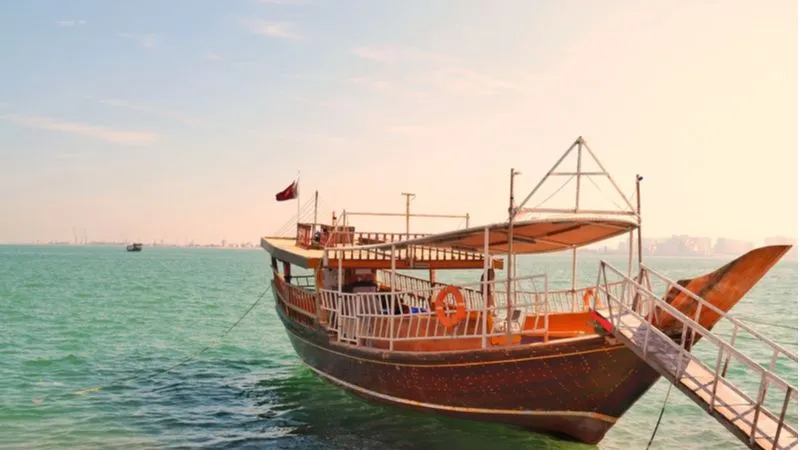The Traditional Dhow Wooden Boat in Qatar is more than just a maritime vessel; it’s a symbol of Qatar’s rich cultural heritage and historical significance. For centuries, these boats have been integral to the country’s identity, playing crucial roles in pearl diving, fishing, and trade. Even today, dhows serve as cultural icons, offering both locals and tourists a glimpse into Qatar’s past.
In this article, we will explore the history, importance, and modern-day applications of the Traditional Dhow Boat in Qatar. From their historical relevance to current tourism use, we’ll provide a comprehensive look at how these boats continue to shape Qatari culture.
Detailed Explanation of Key Concepts
- What is a Traditional Dhow Wooden Boat?
A Traditional Dhow Wooden Boat is a handcrafted sailing vessel commonly made from teak wood and other durable materials. Known for their distinctive curved hulls and triangular sails, dhows have been a part of Qatari life for centuries. Originally designed for fishing and long-distance trading across the Arabian Gulf and Indian Ocean, these boats symbolize Qatar’s deep connection to the sea.
The design of a dhow varies based on its intended use. Larger dhows, such as the Boom or Sambuk, were used for long voyages, transporting goods like spices, textiles, and dates between regions. Smaller versions, like the Jalibut, were often employed for fishing or short trips. Despite their utilitarian purposes, dhows are also admired for their beauty, showcasing the craftsmanship of traditional boat builders.
- The Historical Significance of the Dhow in Qatar
Historically, the Traditional Dhow Wooden Boat was essential to Qatar’s economy and way of life. Before the discovery of oil, pearl diving was Qatar’s most lucrative industry. During the pearl diving season, fleets of dhows would set sail, manned by expert divers and sailors who would spend months at sea. These boats not only transported the pearl divers but also served as their temporary homes.
Beyond pearl diving, dhows played a pivotal role in trade. These boats connected Qatar with distant regions, enabling the exchange of goods and fostering economic and cultural relationships. The dhow was an indispensable part of Qatar’s trade routes, carrying valuable commodities like pearls, silk, spices, and metals between the Arabian Peninsula, Africa, and South Asia.
- Types of Dhows in Qatar
Different types of dhows serve various purposes, each with a unique design suited to its specific function:
Boom: A large cargo-carrying dhow, primarily used for long-distance trade.
Sambuk: A slightly smaller version used for pearl diving.
Jalibut: A small fishing dhow, typically used for short excursions.
Shu’ai: Another small dhow, similar to the Jalibut, mainly used for coastal fishing trips.
These distinctions demonstrate the versatility of the dhow, whether for trade, fishing, or cultural representation. Even today, dhow designs are preserved and respected as a testament to the skill of the najjaars (traditional boatbuilders).
Importance and Benefits of the Traditional Dhow Wooden Boat in Qatar
- Preserving Cultural Heritage
The Traditional Dhow Wooden Boat is a vital part of Qatar’s national identity, preserving the maritime history that predates the country’s oil wealth. By maintaining the tradition of dhow building, Qatar ensures that its historical legacy continues to thrive, bridging the past and the present. The preservation of these boats also honors the craftsmanship passed down through generations, with boatbuilders using techniques that remain largely unchanged for centuries. - Tourism and Cultural Promotion
Today, the dhow is an integral part of Qatar’s tourism industry. Dhow cruises along the Doha Corniche provide visitors with stunning views of the city’s modern skyline contrasted with its traditional seafaring roots. These cruises offer a unique experience for tourists, featuring traditional Qatari music, authentic cuisine, and insights into the history of the dhow.
In addition to leisure cruises, cultural festivals like the Katara Traditional Dhow Festival celebrate Qatar’s maritime heritage. These events include boat races, workshops on dhow building, and exhibitions of pearl diving equipment, giving locals and tourists alike a chance to connect with Qatar’s rich history.
- Economic and Educational Significance
The dhow continues to contribute to Qatar’s economy through tourism and education. Schools often take students on dhow trips to educate them about Qatar’s maritime history, ensuring that future generations understand the significance of these vessels. Additionally, dhow tourism creates jobs for locals, from boat operators to tour guides, helping sustain traditional livelihoods.
The Traditional Dhow Wooden Boat also serves as a living classroom for boatbuilding apprentices, who learn the art of constructing these vessels from seasoned craftsmen. This ensures the survival of an ancient skill that remains deeply connected to Qatar’s identity.
Applications and Use Cases of the Traditional Dhow Wooden Boat
- Leisure and Tourism
In modern-day Qatar, the dhow has found new life as a popular attraction for tourists. Dhow cruises along the Doha Corniche are among the most sought-after experiences for visitors. These tours often include:
Sunset cruises, where guests can enjoy the changing colors of the sky while sailing along Qatar’s coastline.
Dinner cruises, which offer traditional Qatari food served onboard while tourists experience the gentle sway of the boat and the ambient sounds of the water.
Island excursions to places like Al Safliya Island, where tourists can swim, snorkel, or simply relax on the sandy shores.
These experiences allow tourists to immerse themselves in Qatari culture while enjoying the country’s natural beauty. Additionally, corporate events and private celebrations such as weddings and anniversaries are frequently held on these boats, highlighting their continued relevance in modern society.
- Cultural Exhibitions and Festivals
The Katara Traditional Dhow Festival is one of the most significant cultural events celebrating Qatar’s maritime heritage. Held annually at Katara Cultural Village, the festival features dhow racing, traditional performances, and exhibitions that showcase the skills of nakhodas (captains) and najjaars (boatbuilders). This event draws participants from across the Gulf, reflecting the dhow’s importance not only in Qatar but throughout the region.
In addition to festivals, dhows are also displayed in museums, such as the Museum of Islamic Art and the Sheikh Faisal Bin Qassim Al Thani Museum, where visitors can learn about Qatar’s maritime history and the role that dhows played in shaping its economy.
Challenges and Solutions for the Traditional Dhow Wooden Boat
- Maintaining Traditional Craftsmanship
One of the primary challenges facing the Traditional Dhow Wooden Boat is the decline in traditional craftsmanship. As modern technology has advanced, fewer young people are learning the skills necessary to build and maintain these boats, risking the loss of an important cultural practice.
Solution: To address this issue, initiatives such as apprenticeship programs and cultural workshops are being promoted by organizations like Katara Cultural Village and the Qatar Foundation. These programs aim to educate young Qataris on traditional boatbuilding techniques, ensuring that the art of dhow construction is preserved for future generations.
- Balancing Tradition with Modern Tourism
While dhow cruises are a popular tourist attraction, there is a challenge in balancing modern amenities with the preservation of the dhow’s traditional elements. Tourists often expect modern comforts like air conditioning and luxurious seating, which can compromise the authentic dhow experience.
Solution: Tour operators are working to strike a balance by incorporating traditional elements such as Qatari music and cuisine while still providing necessary comforts. This ensures that visitors enjoy an authentic experience while also feeling comfortable during their trip.
- Environmental Impact
As tourism increases, so does the risk of environmental degradation. The increased use of dhows for tours and private events can lead to pollution and damage to Qatar’s coastal ecosystems.
Solution: The Qatari government and dhow operators are implementing sustainable practices to minimize environmental impact. This includes using eco-friendly materials for boat construction and promoting waste reduction and clean energy during tours. Educational campaigns also encourage tourists to respect the natural environment during their dhow trips.
Conclusion
The Traditional Dhow Wooden Boat in Qatar remains a vital link between the country’s past and its present. From its historical roots in pearl diving and trade to its modern-day role in tourism and cultural preservation, the dhow continues to be an important symbol of Qatar’s identity.
By embracing both its cultural significance and practical applications, Qatar has ensured that the Traditional Dhow Wooden Boat will continue to be a celebrated part of its heritage. Whether you’re a tourist seeking an authentic Qatari experience or a local looking to reconnect with your country’s history, the dhow offers an unforgettable journey through Qatar’s rich maritime past.






